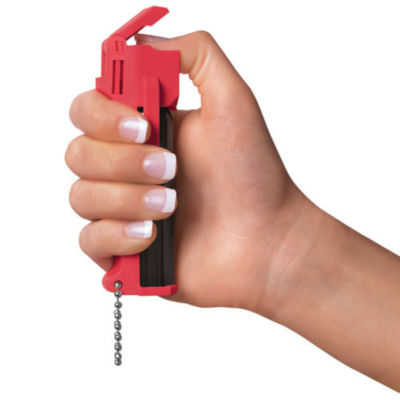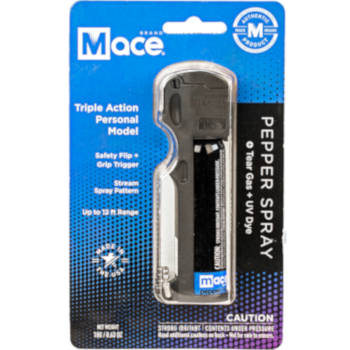Can You Take Pepper Spray On A Plane?

Travel Safe with Self-Defense Knowledge
Planning a trip and wondering, “Can you bring pepper spray on a plane?” Picture yourself packing for a solo flight, wanting to carry your trusted Mace Keyguard Mini for safety. With over 1 in 4 women feeling unsafe while traveling, per RAINN, knowing TSA rules is crucial. Pepper spray is banned in carry-on luggage but allowed in checked luggage with restrictions, according to TSA guidelines. This guide explains TSA and airline policies, international travel rules, and TSA-approved alternatives like the Mini Personal Alarm Keychain. Stay safe and travel confidently with TBOTECH’s self-defense solutions!
Prepare for your trip! Shop TBOTECH’s Pepper Spray collection for protection!
Mace Triple Action Has Safety Cap
TSA Rules for Pepper Spray on Planes
The Transportation Security Administration (TSA) has strict rules for pepper spray, including mace, due to its aerosol nature and potential for misuse, according to the TSA. Here’s what you need to know:
- Carry-On: Pepper spray is prohibited in carry-on luggage, including purses or backpacks, to prevent in-flight incidents.
- Checked Luggage: One canister (up to 4 oz) is allowed in checked bags if it has a safety mechanism to prevent accidental discharge and contains less than 2% tear gas (e.g., CS or CN).
For compliant travel, pack a Pepper Shot Keychain Pepper Spray in your checked bag, featuring a safety lock and 10% OC formula for 8-foot defense.
Airline and International Travel Considerations
While TSA allows pepper spray in checked luggage, airline policies vary, and international destinations have stricter rules. For example:
- Airline Policies: Some airlines, such as Delta or United, may prohibit pepper spray entirely, even in checked baggage. Check your airline’s website before packing.
- International Flights: Countries like the UK and Canada ban pepper spray outright, risking confiscation or fines at customs—research destination laws to avoid legal issues.
Before flying, contact your airline to verify the destination's regulations. For international travel, consider a Personal Alarm for universal, legal protection with a 130 dB siren.
Travel Scenarios: Packing and Staying Safe
Navigating pepper spray rules can be tricky, so here are practical scenarios to stay safe:
- Solo Traveler: You’re flying to a conference and want self-defense. Pack a Mace Triple Action Police Pepper Spray ($19.99) in your checked bag; it’s under 4 oz with a safety cap. Carry a Tactical Flashlight in your carry-on to disorient threats with a high-lumen beam.
- International Trip: Heading to London, where pepper spray is banned? Leave it at home and carry a Panic Alarm Keychain ($10.95) to deter attackers without legal risks.
- Hotel Safety: At your destination, keep a Door Alarm in your hotel room to alert you of unauthorized entry, enhancing nighttime security.
These strategies ensure you’re protected while complying with TSA and local laws.
What Happens If You Bring Pepper Spray in Carry-On?
Attempting to bring pepper spray in your carry-on can lead to:
- Confiscation: TSA will seize the canister at the security checkpoint, delaying your travel.
- Fines or Legal Issues: Depending on the airport, you may face fines or questioning.
- Missed Flights: Security delays could cause you to miss your flight, disrupting your plans.
To avoid these risks, always pack pepper spray in checked luggage or opt for a TSA-approved Personal Alarm for carry-on safety.
TSA-Approved Self-Defense Alternatives for Travelers
Since pepper spray is banned in carry-ons, TBOTECH offers these TSA-approved alternatives for in-flight safety:
- Personal Alarm Keychain: Emits a 130 dB siren to deter threats, legal in carry-ons and checked bags.
- SOSFlashlight: Delivers a high-lumen beam to disorient attackers, perfect for travel.
- Tactical Pen: A discreet, non-lethal striking tool, allowed in carry-ons (as long as it's primarily for writing), ideal for close-range defense.
Can be used as a Kubotan
Equip yourself with a Tactical Pen ($12.95) for worry-free travel protection.
Frequently Asked Questions (FAQs)
Can you bring pepper spray on a plane?
No, pepper spray is banned in carry-on luggage but allowed in checked bags (up to 4 oz with a safety mechanism). Pack a HALO Pepper Spray ($14.00) in your checked luggage for compliance.
Can you check pepper spray on a plane?
Yes, one canister (up to 4 oz, less than 2% tear gas) is allowed in checked luggage with a safety lock, per TSA rules.
What are TSA-approved self-defense alternatives?
Personal alarms and tactical flashlights are allowed in carry-ons. A Personal Alarm offers loud, legal protection for travelers.
Travel Smart with TBOTECH
Pepper spray can’t go in your carry-on, but with proper packing and TSA-approved alternatives, you can stay safe on any trip. TBOTECH’s Pepper Spray, Keychain Sprays, and Personal Alarms ensure protection wherever you travel. All backed by our 90-day guarantee and free shipping over $50. Stay secure, travel confidently—shop TBOTECH today!
Add your comment now!
Post Comment

